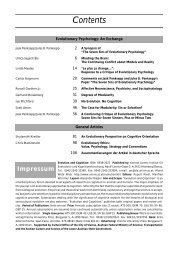Contents - Konrad Lorenz Institute
Contents - Konrad Lorenz Institute
Contents - Konrad Lorenz Institute
Create successful ePaper yourself
Turn your PDF publications into a flip-book with our unique Google optimized e-Paper software.
A Test for Comprehension of False Belief in Chimpanzees<br />
Correct Responses (%)<br />
Correct Responses (%)<br />
80<br />
70<br />
60<br />
50<br />
40<br />
30<br />
20<br />
10<br />
0<br />
90<br />
80<br />
70<br />
60<br />
50<br />
40<br />
30<br />
20<br />
10<br />
0<br />
current<br />
previous<br />
other<br />
3-yr 4-yr 5-yr 6-yr Autistics Chimps<br />
3-yr 4-yr 5-yr 6-yr Autistics Chimps<br />
Figure 4. Percentage of choices made for the previous and current<br />
peg positions and the other two positions (combined) in<br />
the mechanical analogue task. Top: True belief version. Bottom:<br />
false belief version.<br />
SMIRNOV tests, P = 0.104 and P = 0.083 respectively;<br />
however, as a check, we ran a non-parametric<br />
ANOVA, but the results were the same: P = 0.042<br />
and P = 0.003 respectively.) Bonferroni post hoc tests<br />
confirm that six-year-olds score significantly higher<br />
(P ≤ 0.027 2-tailed) than all other groups of subjects<br />
except the chimpanzees (for whom P = 0.48 2-<br />
tailed) on the false belief tasks, but not on the true<br />
belief tasks (except against the chimpanzees, where<br />
P = 0.058 2-tailed). Conversely, the chimpanzees<br />
differ significantly (P ≤ 0.058 2-tailed) from all the<br />
human subjects (except the five-year-olds and autistic<br />
subjects, for whom P ≥ 0.38) on truth belief tasks,<br />
but not on the false belief tasks.<br />
An alternative way of considering the results is to<br />
compare the number of occasions when subjects selected<br />
the previous and current positions of the pegs<br />
in the true belief and false belief trials. Subjects<br />
should choose the current position in true belief trials<br />
and the previous position in false belief trials.<br />
Figure 4 plots the mean percentage of choices for<br />
the four drawers (summing the scores for the two<br />
“other” choices). It is clear from these results that<br />
only the 6-year-olds showed the correct switch from<br />
current to previous peg position between the two<br />
types of trials. Younger children and the autistic<br />
adults all exhibited a strong tendency to select the<br />
previous position of the peg in both types of trial.<br />
Significantly, perhaps, chimpanzees exhibited a<br />
weak tendency to switch choices correctly with trial<br />
type, even though they made many more incorrect<br />
decisions (“other” drawers) than any of the human<br />
subjects. However, only one chimpanzee (Josie) selected<br />
the previous peg position on false belief trials<br />
and the current one on true belief trials significantly<br />
more often than expected by chance (“other”<br />
choices discounted: 2 × 2 χ 2 = 21.88, df = 1,<br />
P < 0.001). Matched pairs t-tests confirmed that, as a<br />
group, only the 6-year-olds chose the previous peg<br />
position significantly more often in the false belief<br />
trials (t = 2.42, df = 9, p < 0.05) and the current peg<br />
position significantly more often in the true belief<br />
trials (t = 2.87, df = 9, p < 0.02); all other comparisons<br />
were non-significant. This suggests that, even<br />
though their performance was far from perfect, the<br />
chimpanzees had a better grasp of the false belief<br />
task than either the autistic adults or the younger<br />
children.<br />
Learning and task performance in chimpanzees<br />
The chimpanzees were given extended trials on<br />
both the true belief and false belief tests in order to<br />
ascertain the extent to which learning might play a<br />
role in their responses to the tasks. Regression analyses<br />
of the results using successive blocks of 10 trials<br />
on each test type are summarised in Table 3.<br />
Pooling results using Fisher’s procedure (with 1-<br />
tailed P-values in a positive direction to test for an<br />
underlying trend for scores to improve with time)<br />
yields χ 2 = 4.56 (df = 2 × 4 = 8, P = 0.80) for the true<br />
belief task and χ 2 = 7.35 (df = 8, P = 0.50) for the<br />
false belief task, indicating that there is no underlying<br />
trend in either case. Indeed, the mean slope on<br />
Subject slope r2 t df* P<br />
(a) True belief trials:<br />
Pepe –0.004 0.00 –0.035 11 0.959<br />
Josie 0.600 0.14 0.707 4 0.530<br />
Flynn –0.100 0.01 –0.141 4 0.897<br />
Beckie 0.114 0.01 0.231 4 0.829<br />
(b) False belief trials:<br />
Pepe –0.025 0.01 –0.273 11 0.717<br />
Josie 0.600 0.53 0.187 4 0.164<br />
Flynn –0.800 0.46 –1.589 4 0.210<br />
Beckie –0.400 0.38 –1.572 4 0.191<br />
Table 3. Regression statistics for a linear trend in correct scores<br />
with blocks of trials for chimpanzees to test for a learning effect.<br />
*blocks of 10 test trials.<br />
Evolution and Cognition ❘ 137 ❘ 2003, Vol. 9, No. 2








